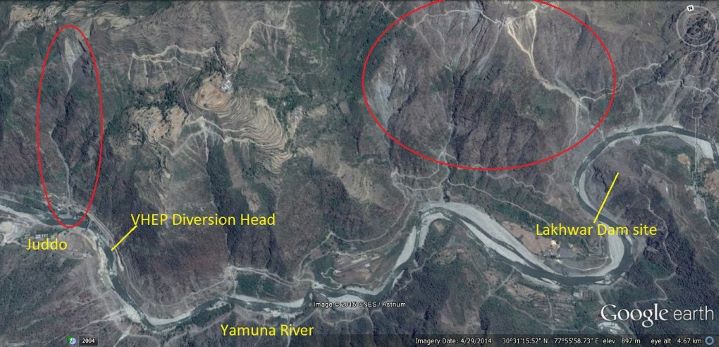Big Dams Will Fail To Solve Water Supply Needs
 Sardar Sarovar Dam- Gujarat
Sardar Sarovar Dam- Gujarat
At a time when the heat wave spread through almost half of the country while monsoons is yet to reach the mainland, water woes have been threatening almost every person in India. With water storage in dams dropping to a “critical” level, the Centre last week issued a “drought advisory” to Maharashtra, Gujarat, Karnataka, Andhra Pradesh, Telangana and Tamil Nadu, asking them to use water judiciously. With soaring temperatures, water levels in the rivers are dropping the dams which interrupt the normal passage of river to store water are risking a water crisis in many regions.
According to researchers from McGill University and WWF, “Indian rivers are exposed to sustained pressure from fragmentation and loss of river connectivity, constraining their capacity to flow unimpeded, affecting many fundamental processes and functions characteristic of healthy rivers,” their study states.
Despite the missing waters in our rivers, authorities have given okay to another controversial massive dam project on the Yamuna.
Lakhwar-Vyasi dam project
On August 28, 2018 the government of India signed off on a Memorandum of Understanding (MOU) with six state governments to go ahead with Lakhwar-Vyasi multi-purpose project. The project situated at the Upper Yamuna basin in Uttarakhand and has once again raised the question of sustainability.

Lakhwar-Vyasi is a 300 MW hydroelectric project (HEP) that involves the construction of 204 metre high concrete dam with a huge 40 kilometre long reservoir on the river Yamuna near Lohari village in Dehradun.
The environmentalists are concerned that the environmental and social impacts of bringing such a mega project in an ecologically fragile area are being overlooked by both the center and the states and that the government has announced the project even though the matter was still in the court.
Something must be said about the decision as Uttarakhand, which once was called the reservoir of India, was reeling under drought in the same year, as 10 out of 13 of its districts faced including Dehradun district in which this project is located was drought hit. Disrupting the river connectivity has diminished and in many areas even eliminated critical ecosystems, causing forest fires in the state.
On this Rashmi Bajaj, state project manager of UNDP said, “An estimated about 2.6 lakh springs provide 90% of the drinking water sources in Uttarakhand. Due to continued deforestation for projects like road, construction, or to meet fuel and fodder demands of local communities, it was found after collecting information from various sources and communities that discharges of 500 water supply sources including springs, streams, ponds etc have reportedly reduced by more than 50%. Climate change will further amplify the reduction of local water resources.”
The project site is also located in an earthquake-prone zone making it vulnerable to disasters. Not just ignoring the ill effects of the project there, authorities had forgotten to ascertain the effects on lower riparian states like Haryana and Uttar Pradesh who have been battling water scarcity and water pollution for quite some time now.
Union minister advocates this project as a solution to Delhi’s water crisis. But these tall claims forget that Delhi’s water issues can be dealt with better planning as talked in a study.

More to Come
The spree of bad decisions does not stop here. There are at least 9 more Dams on the design board. This includes world’s tallest concrete gravity dam known as Dibang Dam in Arunachal Pradesh, Bursar Hydroelectric Project in Kishtwar, Second Siruvani Dam, dam across the Cauvery river at Mekedatu and Mahanadi Godavari Link with Manibhadra Dam on river Mahanadi in Odisha.
Others include:
a) Kalpasar Project: World’s largest man-made freshwater reservoir in the sea which will connect Saurashtra and South Gujarat, which is reeling under water crisis at present.
b) Icchampally Project: A joint project of Telangana, Maharashtra and Chhattisgarh which are drought prone.
c) Kishau Dam: Gravity dam on Tons river be located at the border of Himachal Pradesh and Uttarakhand which is an ecologically sensitive area.
d) Pakal Dul Dam: The Project on the Marusadar river is a concrete face rock fill dam in Kishtwar district of Jammu and Kashmir, another sensitive area.
According to official data 36 dams have so far failed in the country, due to breaching by flood, Overtopping, Piping/Bad Workmanship or other reasons. The data also points out the likeliness of failure in different types of dams.
Even after the availability of over 30 case studies, the government seems to be adamant in wasting resources in creating faulty structures whose success continually depend on erratic monsoons and other climatic phenomena. Majority of Indian dams have failed immediately after construction or at the time of first full-load, due to either inadequate design or poor quality of construction. With an increasing number of dams becoming older, the likelihood of dam failures in India is expected to rise. This simply points out that the country does not need more dams; they just need a better plan for management and maintenance of the existing infrastructure and newer technology adoption to slowly remove their reliance on these megastructures.









